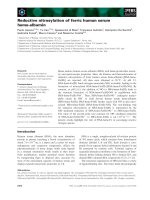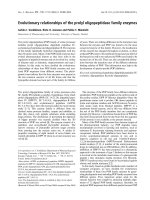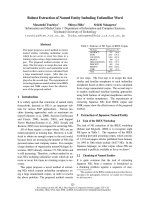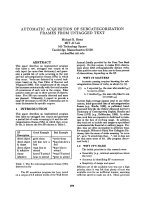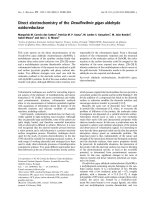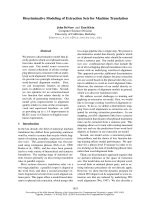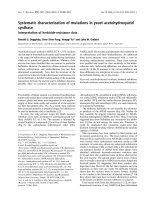báo cáo khoa học: "Clinical relevance of "withdrawal therapy" as a form of hormonal manipulation for breast cancer" doc
Bạn đang xem bản rút gọn của tài liệu. Xem và tải ngay bản đầy đủ của tài liệu tại đây (207.99 KB, 4 trang )
RESEARC H Open Access
Clinical relevance of “withdrawal therapy” as a
form of hormonal manipulation for breast cancer
Amit Agrawal
*
, John FR Robertson and KL Cheung
Abstract
Background: It has been shown in in-vitro experiments that “withdrawal” of tamoxifen inhibits growth of tumor
cells. However, evidence is scarce when this is extrapolated into clinical context. We report our experience to verify
the clinical relevance of “withdrawal therapy”.
Methods: Breast cancer patients since 1998 who fulfilled the following criteria were selected from the
departmental database and the case-notes were retrospectively reviewed: (1) estrogen receptor positive, operable
primary breast cancer in elderly (age > 70 years), locally advanced or metastatic breast cancer; (2) disease deemed
suitable for treatment by hormonal manipulation; (3) disease assessable by UICC criteria; (4) received “withdrawal”
from a prior endocrine agent as a form of therapy; (5) on “withdrawal therapy” for ≥ 6 months unless they
progressed prior.
Results: Seventeen patients with median age of 84.3 (53.7-92.5) had “withdrawal therapy” as second to tenth line
of treatment following prior endocrine therapy using tamoxifen (n = 10), an aromatase inhibitor (n = 5), megestrol
acetate (n = 1) or fulvestrant (n = 1). Ten patients (58.8%) had clinical benefit (CB) (complete response/partial
response/stable disease ≥ 6 months) with a median duration of Clinical Benefit (DoCB) of 10+ (7-27) months. Two
patients remain on “withdrawal therapy” at the time of analysis.
Conclusion: “Withdrawal therapy” appears to produce sustained CB in a significant proportion of patients. This
applies not only to “withdrawal” from tamoxifen, but also from other categories of endocrine agents. “Withdrawal”
from endocrine therapy is, therefore, a viable intercalating option between endocrine agents to minimise
resistance and provide additional line of therapy. It should be considered as part of the sequencing of endocrine
therapy.
Background
Estrogen receptor (ER) positive breast cancers after a
period of response to anti-estrogens develop resist ance
and clinically the disease progresses. Besides the predo-
minant role of alternative signalling pathways, domina-
tion of partial agonistic activity of tamoxifen over its
antagonist activity has been implicated for acquired
resistance [1]. Regression of tumor on cessation of
tamoxifen therapy and the resultant clinical benefit (CB)
have been reported in several case-reports and ser ies
[2-6]. In-vitro experiments have also shown that “with-
drawal” of tamoxifen inhibits growth of tumor cells [7].
We report clinical relevance of “withdrawal therapy”
from tamoxifen and other hormonal agents in patients
heavily pre-treated with endocrine therapy.
Methods
Case-notes of the breast cancer patients treated in the
Nottingham breast unit since 1998 fulfilling the follow-
ing criteria were studied retrospectively:
• ER positive invasive breast carcinoma proven by
histology (Standard Immuno-histochemically esti-
mated H score ≥ 50 accepted as ER +) [8]
• Primary operable cancer in elderly (age > 70 years)
(who were frail or refused to undergo surgery),
locally advanced or metastatic
• Disease deemed suitable for further hormonal
manipulation
* Correspondence:
Division of Breast Surgery, GEM School, University of Nottingham, Royal
Derby Hospital, Derby DE22 3NE, UK
Agrawal et al. World Journal of Surgical Oncology 2011, 9:101
/>WORLD JOURNAL OF
SURGICAL ONCOLOGY
© 2011 Agrawal et al; licensee BioMed Central Ltd. This is an Open Access article distrib uted under the terms of the Creative Co mmons
Attribution License ( whi ch permits u nrestrict ed use, distribution, and reproduction in
any medium, provided the original work is properly cited.
• Disease progressed on a hormonal agent and thus
suitable for “withdrawal” from an endocrine agent as
a therapeutic option (as opposed to a palliative
option)
• Assessable lesions were deemed to have shown CB
when they either had objective respons e in the form
of complete response (CR) or partial response (PR);
or had stable disease (SD) for ≥ 6 months in accor-
dance with UICC criteria [9,10]
• Metastatic lesions were assessed radiologically (CT
scan/X-rays/bone scan) every 3 months as routine
protocol in the unit
• On “withdrawal therapy” foratleast6months
unless disease progressed prior
Duration of CB (DoCB) is the duration of therapy in
months only in patients who have derived CB and
including patient still on treatment. Duration of treat-
ment (DoT) is the duration of therapy in months of all
patients (regardless of the type of response) and includ-
ing patient still on treatment
Results
Seventeen patients with either locally advanced primary (n
= 3) or metastatic (n = 14) breast cancer had “withdrawal”
treatment as 2nd to 10th line of treatment. Patient and
tumor characteristics are shown in Table 1. Two patients
were still on follow-up at analysis. The results from “with-
drawal” from different agents are shown in the Table 2.
Drugs prior to withdrawal were mostly several lines of
endocrine agents (tamoxifen, aromatase inhibitors, AIs-
letrozole and exemestane, fulvestrant, megestrol acetate)
but some had radio and chemotherapy as necessary. How-
ever, in current study, only patients in whom the preced-
ing therapy was an endocrine agent were conside red for
withdrawal (as mentioned in Table 2).
Discussion
Tamoxifen may continue to provide antagonistic activity
on ER nuclear signalling activity but may act as an
agonist on the ER membrane signalling activity which
could explain the loss of continuing CB to some patients
on long-term tamoxifen therapy [1]. There is significant
and sustained CB (60%) on “withdrawal” from tamoxifen
even in hea vily pre-treated patients in our study. Pre-
vious studies have explained development of resistance
to tamoxifen itself due to clonal selec tion of breast can-
cer cells that grow in the presence of tamoxifen [4,6].
An in vitro study of cells derived from t umors of post-
menopausal patients which progressed on tamoxifen
showed growth enhanced by addition of tamoxifen [11]
suggesting domination of agonistic activity on long-term
tamoxifen therapy.
In an in-vivo study [12], athymic mice were trans-
planted with ER positive t umor cells and then exposed
to tamoxifen or placebo. The tumors regressed initially
over 4 months but started to grow towards the end of
the study (8 months) on long-term exposure to tamoxi-
fen and placebo. Tumors from both groups were re-
transplanted into athymic mice. Tumors which grew in
the presence of tamoxifen grew either on exposure to
estrogen or on exposure to further tamoxifen. In clinical
setting, therefore, cessation o f further growth would be
expected on withdrawal of tamoxifen therapy at devel-
opment of resistance to tamoxifen. Our case-series and
previously reported case series confirm this finding in
clinical setting.
The lack of response in the remaining patients on
withdrawal of tamoxifen could partly be explained b y
the growth promoting action of natural estrogen in the
body as seen in the abov e in-vivo study [12]. Therefore,
if “withdrawal therapy” from tamoxifen does not provide
any clinically benefi cial response, an AI or fulvestrant
maybethesubsequentendocrineagentsofchoiceto
negate the effects of persisting estrogen. This tactic of
manipulating hormonal e nvironment of the tumor pro-
vides a viable intercalating option between endocrine
agents without possible side-effects.
In our study, as seen in table 2, there were a group of
patients who were on endocrine agents other than
Table 1 Patient and Tumour characteristics
Median age = 84.3 (53.7-92.5) years
Histopathology Invasive adenocarcinoma = 12 Mixed Tubular + Cribriform = 1 Not
available = 4
Median ER (estrogen receptor) H score 185 (IQR, 97.5-222)
Median Disease Free Interval (DFI) 84 (IQR, 19-180) months
Metastatic Sites Bone = 6
Pleura/Effusion = 4
Lung = 2
Liver = 5 Supraclavicular/mediastinal Lymph node = 2
Median lines of therapy prior to withdrawal 5 (range 1-9)
Median TTP (time to progression) on endocrine agent prior to
withdrawal
6 (IQR, 3-17) months
Agrawal et al. World Journal of Surgical Oncology 2011, 9:101
/>Page 2 of 4
tamoxifen (megestrol acetate, aromatase inhibitors, and
fulvestrant). Therapy in these patients was withdrawn
either due to side-effects or patient unfitness/refusal. No
further endocrine therapy was instituted as they already
had multiple lines of other therapies. On routine clinical
follow-up, incidental responses were seen in these
patients. It is difficult to explain incidental responses to
withdrawal from categories of endocrine agents other
than tamoxifen or an AI. It could be due to paradoxical
action of natural estrogens rebounding after “withdra-
wal” of anti-estrogens without agonist activity [1,13]. In
an in-vitro study in MCF-7 cells by Masamura et al [14]
long-term estrogen deprivation (akin to usage of anti-
estrogens in the form of AIs clinically) led these cells to
develop estrogen hypersensitivity. In a long-term estro-
gen deprived aromatase resistant breast cancer cell
model (MCF-7:5C), O sipo et al [7] demonstrated apop-
tosis at a concentration of 10
-11
M/L or more of estra-
diol. This is again po ssible due to activation of cross-
talk mechanisms and domination of mitogen-activated
protein kinase or growth factors [1].
The above in-vitro concept is being explored further
in clinical settings. There is ongoing recruitment to a
phase III tria l (SOLE trial, Study Of Letrozole Extension
trial) wherein node positive early stage patients who
have completed 4-6 years of prior adjuvant endocrine
therapy (a SERM/AI/both) are randomised to receive
either 5 years of daily letrozole or receive intermittent
letrozole regime (daily for first 9 months of 1
st
4 years
followed by 12 months in year 5)[15]. The rationale for
this study is that long-term estrogen deprivation by an
AI reduces the sensitivity of the tumour cells to therapy
and interruptions to therapy allows resurgence of estro-
genic stimulation leading to restoration of sensitivity to
letrozole on its reintroduction.
In locally advanced and advanced bre ast cancer, ide-
ally, inhibitors of the alternative pathways would be the
subsequent logical therapy following resistance to other
endocrine agents. However, if the patient is unfit t o
receive any further anti-estrogen therapy then it is very
likely that they would not be suitabl e for further growth
factor inhibitors or indeed chemotherapeutic agents. In
this circumstance, withdrawal of therapy may be the
only feasible option or alternating regime of endocrine
therapy and withdrawal therapy as is being tested in the
adjuvant setting in the SOLE trial.
Conclusions
Our data therefore provides some clinical evidence and
emphasises the relevance of withdrawal therapy. The
concept is being tested in large randomised trials in
adjuvant settings. However, larger datasets and results of
ongoing adjuvant trials are needed to provide confirma-
tory evidence for or against the concept and feasibility
of withdrawal therapy in locally advanced and metastatic
breast cancer.
Acknowledgements
None
Authors’ contributions
KLC conceived this study. Patients were under care of JFR and KLC. AA
collected data, performed analysis, drafted, revised and finalised the
manuscript. KLC and JFR revised and approved of the contents of the
manuscript. All authors read and approved the final manuscript.
Conflict of interests
The authors declare that they have no competing interests.
Received: 2 April 2011 Accepted: 9 September 2011
Published: 9 September 2011
References
1. Osborne CK, Shou J, Massarweh S, Schiff R: Crosstalk between Estrogen
Receptor and Growth Factor Receptor Pathways as a Cause for
Endocrine Therapy Resistance in Breast Cancer. Clinical Cancer Research
2005, 112:865s-870s.
2. Legault-Poisson S, Jolivet J, Poisson R, Beretta-Piccoli M, Band PR:
Tamoxifen-induced tumor stimulation and withdrawal response. Cancer
Treat Rep 1979, 6311-12:1839-1841.
3. Stein W, Hortobagyi GN, Blumenschein GR: Response of metastatic breast
cancer to tamoxifen withdrawal: report of a case. J Surg Oncol 1983,
221:45-46.
4. Canney PA, Griffiths T, Latief TN, Priestman TJ: Clinical significance of
tamoxifen withdrawal response. Lancet 1987, 18523:36.
5. Belani CP, Pearl P, Whitley NO, Aisner J: Tamoxifen withdrawal response.
Report of a case. Arch Intern Med 1989, 1492:449-450.
6. Howell A, Dodwell DJ, Anderson H, Redford J: Response after withdrawal
of tamoxifen and progestogens in advanced breast cancer. Annals Of
Oncology: Official Journal Of The European Society For Medical Oncology/
ESMO 1992, 38:611.
7. Osipo C, Gajdos C, Cheng D, Jordan VC: Reversal of tamoxifen resistant
breast cancer by low dose estrogen therapy. J Steroid Biochem Mol Biol
2005, 932-5:249-256.
Table 2 Disease distribution and Clinical results
Patients (n) Disease type CB = n (%) DoCB in months DoT in months
All (n = 17) 14 MBC
3 LAPC
10 (58.8%); 1PR,9SD
(8 MBC & 2 LAPC)
10+ (7-27) 9+ (1-27)
Tamoxifen (n = 10) 9 MBC
1 LAPC
6 (60%); 1 PR, 5 SD
(6 MBC)
10.5+ (7-27) 8.5+ (1-27)
Rest (n = 7)
1M,1F,4E,1L
5 MBC
2 LAPC
4 (57.1%); 4 SD
(2 MBC & 2 LAPC)
9.5+ (9-23) 9+ (2-23)
M = Megestrol acetate; F = Fulvestrant; E = Exemestane; L = Letrozole; MBC = Metastatic Breast Cancer; LAPC = Locally Advanced Primary Breast Cancer; PR =
Partial Response; SD = Stable Disease; DoCB = Duration of Treatment in patients with Clinical Benefit; DoT = Duration of Treatment irrespective of response
Agrawal et al. World Journal of Surgical Oncology 2011, 9:101
/>Page 3 of 4
8. McClelland RA, Finlay P, Walker KJ, Nicholson D, Robertson JF, Blamey RW,
Nicholson RI: Automated quantitation of immunocytochemically localized
estrogen receptors in human breast cancer. Cancer Res 1990,
5012:3545-3550.
9. British Breast Group: Assessment of response to treatment in advanced
breast cancer. Lancet 1974, 2:38-39.
10. Hayward JL, Carbone PP, Heuson JC, Kumaoka S, Segaloff A, Rubens RD:
Assessment of response to therapy in advanced breast cancer: a project
of the Programme on Clinical Oncology of the International Union
Against Cancer, Geneva, Switzerland. Cancer 1977, 393:1289-1294.
11. Simon WE, Albrecht M, Trams G, Dietel M, Holzel F: In vitro growth
promotion of human mammary carcinoma cells by steroid hormones,
tamoxifen, and prolactin. J Natl Cancer Inst 1984, 732:313-321.
12. Gottardis M, Jordan V: Development of Tamoxifen-stimulated Growth of
MCF-7 Tumors in Athymic Mice after Long-Term Antiestrogen
Administration. Cancer Res 1988, 48:5183-5187.
13. Agrawal A, Robertson JF, Cheung KL: Efficacy and tolerability of high dose
“ethinylestradiol” in post-menopausal advanced breast cancer patients
heavily pre-treated with endocrine agents. World J Surg Oncol 2006, 4:44.
14. Masamura S, Santner SJ, Heitjan DF, Santen RJ: Estrogen deprivation
causes estradiol hypersensitivity in human breast cancer cells. J Clin
Endocrinol Metab 1995, 8010:2918-2925.
15. SOLE trial Newsletter No 8, March 2011. [http://www.
breastinternationalgroup.org/LinkClick.aspx?fileticket=dmcZc0avwBc%
3d&tabid=2341].
doi:10.1186/1477-7819-9-101
Cite this article as: Agrawal et al.: Clinical relevance of “withdrawal
therapy” as a form of hormonal manipulation for breast cancer. World
Journal of Surgical Oncology 2011 9:101.
Submit your next manuscript to BioMed Central
and take full advantage of:
• Convenient online submission
• Thorough peer review
• No space constraints or color figure charges
• Immediate publication on acceptance
• Inclusion in PubMed, CAS, Scopus and Google Scholar
• Research which is freely available for redistribution
Submit your manuscript at
www.biomedcentral.com/submit
Agrawal et al. World Journal of Surgical Oncology 2011, 9:101
/>Page 4 of 4
